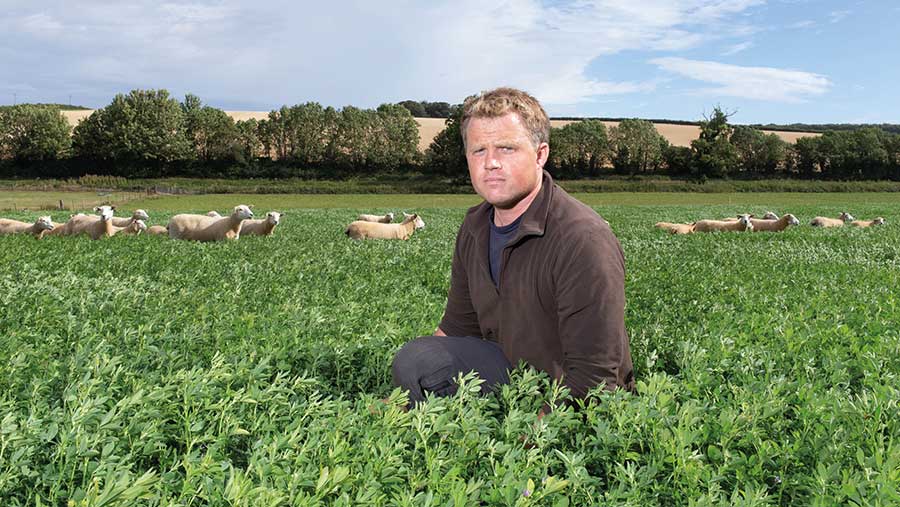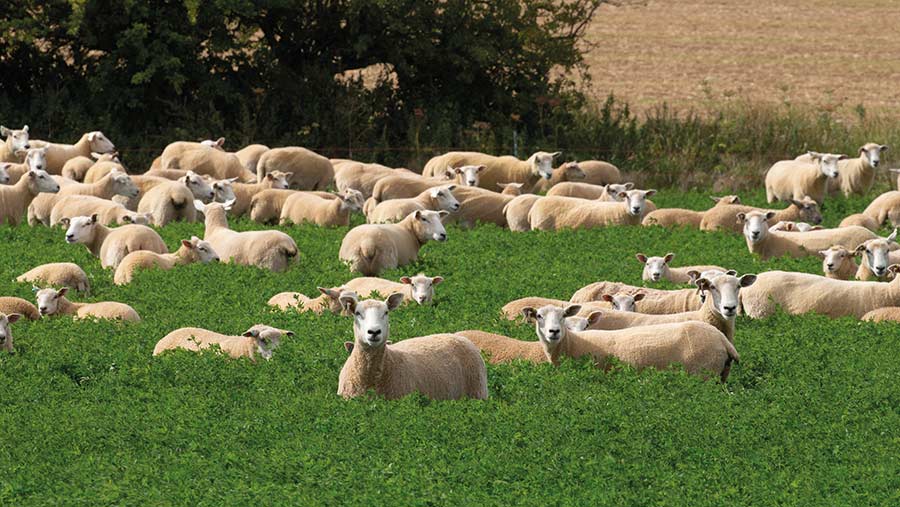How lucerne could help bridge summer forage gap
 © Tim Scrivener
© Tim Scrivener A pioneering project will finally give UK farmers an insight into the practicalities of growing and feeding sheep lucerne.
Lucerne is widely used as a crop for grazing sheep in New Zealand, but in the UK it is largely ensiled for total mixed ration systems.
The trial, which is being supported by Innovative Farmers and carried out at two UK farms, will investigate if it is possible to extend the grazing season for sheep by using lucerne.
See also: The benefits of growing and feeding lucerne to dairy cows
Historically, arable and sheep farmer David Cross has used perennial ryegrass, white clover, chicory and plantain grass leys to graze his flock of 950 ewes and ewe lambs at Glovers Farm in north Norfolk.
Farm facts
- 750 mixed-aged ewes and 250 ewe lambs (New Zealand Texel cross Romney and Easydams)
- Multiplier for Easyrams
- Tenant on the Sedgeford Hall Estate
- Farming 385ha (950 acres) and renting 40ha (100 acres) of permanent grass
But extended periods of dry weather resulted in forage pinches in the summer.
“We have quite light soils and it is quite common for us to get six weeks without rain,” explains Mr Cross, who farms 385ha (950 acres) on a tenancy.
To help alleviate the pressure on twin-bearing ewe lambs and improve weaning weights, he originally installed a milking machine to rear the second lamb.
But he concedes it was too expensive and a lot of extra work.
Keen to improve soil condition and explore alternatives to rising costs and increasing use of nitrogen, Mr Cross visited New Zealand on a study trip to examine how lucerne could fit into his system.
He then began the two-year project last year with help from lead researcher Liz Genever, who is overseeing the project and collecting data on:
- Ewe body condition scores (BCS)
- Lamb weights
- Blood samples, to check for trace element status
- Worm burdens using regular faecal egg counts
- Mortality
- Soil condition.
Over the course of the trial, Farmers Weekly will follow the progress at Glovers Farm.
In this first article, we visited the farm to report on the first set of results post weaning.
Establishment
An 6ha block of lucerne was established in June 2019 following a failed crop of rape and chicory, but the rapeseed was decimated by flea beetle. A second, 2ha adjoining paddock was drilled in May.
Establishment method:
- Single pass cultivation
- Cambridge rolled
- Drilled
- Rolled again
- Herbicide applied at the three-leaf phase to remove fat hen which has been prolific this year
The lucerne variety, Luzelle, was chosen for its low growing point and, therefore, improved tolerance to grazing and reasonable winter dormancy.
Mr Cross has a good availability of winter cover crops so ewes can be moved off the farm to allow lucerne enough time to rest over the winter.
Seed was drilled at 25kg/ha (10kg/acre).
Rotation
One-hundred and one twin-bearing ewe lambs (scanned at 138% after two cycles) were transitioned on to the 15cm crop one month pre-lambing and given access to fodder beet and a back run of grass. Lambing started on 5 April for 32 days.
They began a rotation one week after lambing finished (14 May).
The field was divided into seven paddocks, about 0.85ha in size. Mr Cross started on a 28-day rotation and extended this to 35 days as covers increased.

© Tim Scrivener
A rotation of 42 days was adhered to post weaning.
Lucerne is high in protein (22-23%) and doesn’t hold any salt, so sheep were given access to rock salt and hay to help balance the rumen and prevent bloat.
Results
Twin-bearing ewe lambs have been compared to mixed-aged ewes that lambed at the same time on grass, clover, chicory and plantain.
Performance compared |
||
|
Mixed-aged ewes |
Ewe lambs |
|
|
Progeny growth rates (g/day up to 100 days at weaning) |
297 |
295 |
|
Progeny growth rates (g/day) after weaning |
180 |
160 |
|
BCS at weaning |
2.5 |
3.5 |
|
Average weight of ewes at weaning (kg) |
52 |
63.7 |
|
Trace element status |
No difference between groups |
|
|
Worm count |
Low |
Low |
“It’s been a ridiculous year. Conditions haven’t been as perfect as we would have wanted them to be,” admits Mr Cross.
In fact, grass burnt off in the summer and some of the ewes and lambs had to be moved to extra permanent grazing, which has made comparisons more difficult.
“Lucerne seemed to benefit the sheep themselves, but intriguingly that wasn’t expressed in extra milk production and growth in the lambs. We were both surprised,” Dr Genever observes.

Next steps
Sheep will be taken off the crop in September to allow it time to recover over winter.
“The target is to get 50% flowering once you’re into the autumn because that means the plant can put enough resources back into the root needed for strong spring growth the following year,” adds Mr Cross.
Next year, mixed-aged ewes will be grazed on the lucerne to make it a fair comparison.
Dr Genever adds: “It’s only one year and one trial, on one farm, so results need to be used with caution.
However, this year we have demonstrated lucerne can put condition on ewe lambs. Next year, we will try to show the benefit of lucerne on lamb performance and rearing rate.”
Mr Cross is also interested to see if rearing performance of ewe lambs will be improved as shearlings because they have weaned in better body condition.
Challenges
- Takes three weeks for them to transition on to the crop.
- Have to ensure constant access to roughage because lucerne has high protein levels (22-23% protein) that can cause digestive upsets.
- Unexpected: High nitrates content in the leaf resulted in photosensitivity (sheep losing wool and suffering sunburn on ears). Exacerbated by the dry spring with nitrates accumulating in the soil and being taken up by the plant when rain occurred. Lambs with sunburn were moved to grass.
- Higher risk of clostridial disease and red gut due to high intake potential and low fibre. Red gut occurs when forage passes from the rumen into the gut without being fully digested and causes a build-up of gas and toxins causing the intestines to twist. A couple of lambs died from clostridial disease despite being vaccinated three times in an attempt to ensure all lambs had at least two vaccines to maximise immune response.
To alleviate these two issues, Mr Cross is considering growing it with cocksfoot, which is very fibrous and has a similar growth pattern.
- Difficult to manage. Cannot measure it with a plate meter. Instead, sward heights must be measured. As a general rule, it needs grazing at 30cm. Up until weaning, rotations can be reduced to 25 days due to fast regrowth. But in the autumn, it needs longer rest periods to avoid depleting root stores, otherwise persistency will be affected, along with spring growth.
Main advantage
Strong and consistent growth despite the drought. During May and June (drought conditions), the plant used its deep tap roots to obtain moisture and continued growing, unlike the grass mix.
